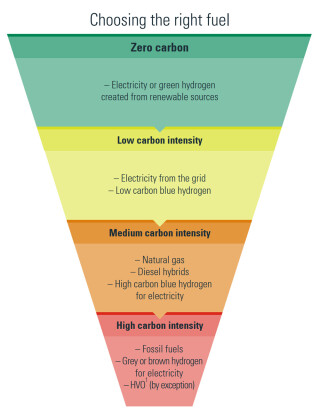You don’t have to be a paid-up member of Just Stop Oil to accept that the days of diesel-powered construction equipment are probably numbered. We might not see diesel die out this decade, but the Construction Leadership Council wants to see it gone by 2035.
The search is on, therefore, for a sustainable, viable alternative to diesel and one of the leaders in this quest is the UK’s biggest contractor, Balfour Beatty.
The company is currently using its £12.5m contract to restore and rebuild structures for Edinburgh’s Royal Botanic Garden as a test-bed for a variety of technologies and fuel types.
“It’s very much our experimental zone where we’re testing out different technology: what works, what doesn’t work and critically what are the pitfalls that we need to avoid,” says Balfour Beatty’s group sustainability director Jo Gilroy.
“We’ve got a little bit of everything – dumpers, excavators, hand tools, generators – it’s a bread-and-butter site,” she adds.
Gilroy has particularly high hopes for one technology – hydrogen power, a fuel source that the UK and Scottish governments are also keen to promote.
“When it comes to hydrogen I think everyone is largely in agreement that there is tremendous potential in this technology,” she says, “but there are also some significant lessons that need to be learned not just in terms of where are we going to source it from – because the hydrogen supply chain is still very much embryonic – but also utilising hydrogen as a fuel source requires us, as a construction business, to work in a very different way.”
There are currently two ways in which hydrogen can be used as a fuel: in the form of a fuel-cell, generating electricity to power a motor; or as a fuel – or fuel additive – for use in a conventional internal combustion engine.
“Our engineering community is split on which is best, but my understanding is that we are more inclined to the hydrogen fuel cell technology because it is more efficient in delivering the energy,” says Gilroy.
However, at the Royal Botanical Garden in Edinburgh, Balfour Beatty is trialling hydrogen as an additive, mixing it with diesel to reduce the amount of fossil fuel required. “We’re working very closely with our partners in this space - organisations like Geopura, a critical partner for us, but also, further into the supply chain, organisations like JCB and Caterpillar which are spending their own dime on equipment research.
“Using hydrogen in internal combustion engines is the quicker route to market but it’s not a cheap route to market,” says Gilroy. “The uplift in cost is quite significant because you’re having to pump more hydrogen through that engine to get the same amount of power.” And with the currently under-developed supply chain, hydrogen is not cheap.
Although she is clearly optimistic about hydrogen’s potential, Gilroy is careful not to give the impression that it’s the only game in town:
“Hydrogen is not the same as diesel, it’s not a drop-in,” she explains. “It requires you to set up your site in a different way; you need more space – hydrogen as a fuel produces more energy per unit than diesel but it’s a gas and is inherently voluminous. Yes, you can compress it, but you still require a degree of space.
“And if, God forbid, you have a leak in a confined space it’s lighter than air and it’s going to drift up to the ceiling and it’s going to sit there. Don’t forget that hydrogen is itself a greenhouse gas – it’s a more potent greenhouse gas than CO2 – so you definitely don’t want leaks.”
So what Gilroy predicts – and what the Edinburgh trial is exploring – is that a low-carbon future will comprise a mixture of different energy sources tailored to specific requirements.
“As an industry we are looking for a panacea that doesn’t exist. There is no one-size-fits-all solution; there is no sustainable fuel out there that doesn’t have a trade-off, a compromise.
When you look at the complexity of a construction site and all of the different pieces of equipment that are run at any given time, there is no fuel – hydrogen included – that is going to do it all.
“So what we are working towards and what we need to be more honest about is which fuels work in which circumstances and what are the trade-offs,” she says.
Balfour Beatty and its supply-chain partners are therefore ‘tinkering’, to quote Gilroy, to find out which is the best solution for any given piece of construction equipment.
“We’re actually moving away from a very simple, unsustainable situation which is: you’ve got your diesel, you know how to store it, you know how to refill, move it around on site and so on – and we’re moving away from that simplicity to a very complicated fuel delivery model for sustainable projects – tinkering to see what type of fuel is best for a given piece of equipment – which will mean drawing on multiple different sources of sustainable fuel.”

Some plant might use renewable electricity from the grid, others will consume hydrogen or drop-in biofuel. And some, perhaps due to some technology lag, will still be running off traditional diesel for years to come.
If this sounds complicated, the reality is even more bewildering. Not all hydrogen is equal and some hydrogen is far from sustainable. ‘Blue’ hydrogen, for example, is derived from hydrocarbons whereas ‘green’ hydrogen is produced using renewable energy from solar panels or wind turbines. Hence, it’s ‘green’.
“Yes, you’ve got blue and green hydrogen, but don’t forget pink, brown, black and grey,” says Gilroy. “‘Black’ and ‘brown’ hydrogen are byproducts from coal; ‘pink’ is from nuclear; ‘grey’ is a byproduct of methane. But blue is from the production of natural gas – again it’s a byproduct.”
In extracting hydrogen from natural gas, you release CO2 – which can be captured and stored. “But there are some studies which suggest the blue hydrogen, for all its environmental benefits, is also quite energy intensive…whereas green hydrogen produces no carbon – it’s just hydrogen produced by electrolysis, so you’re running a current through water and that current is produced by renewable energy.”
Last year, Balfour Beatty caused a stir when it put a stop to the use of HVO – or hydro-treated vegetable oil – on its sites. HVO, a drop-in replacement for diesel, is nominally derived from used cooking oil and is therefore considered not only a non-fossil fuel but also a sustainable, recycled waste product.
HVO enjoyed a huge surge in popularity in the run-up to the UK government’s ban on the use of tax-rebated ‘red’ diesel in construction and other industries which came into force in April 2022. Although Gilroy insists there is no panacea, no one-size-fits-all solution, many in the industry believed that there was and that is was HVO.
Balfour Beatty’s HVO moratorium (which was soon taken up by others, including the Environment Agency) was a response to growing doubts about the sustainability of the fuel. Used cooking oil is a finite resource and it is feared that growing demand will result in widespread deforestation to make way for oil-palm plantations to meet the demand for HVO.
Gilroy says the jury is still out on HVO. “Fundamentally, there isn’t enough volume of HVO to meet what would be the demand from the construction sector – and remember we’re not the only sector looking at it. We’re one of many. The HVO that’s currently in existence is fully utilised by existing industries,” she says.
“I do think HVO has a place but we need to be really clear on the transparency around how is it sourced, where does it come from, which country’s producing it, what are the raw ingredients and what is the true environmental benefit.”
There is no such clarity at present, says Gilroy. “We don’t have an independent voice on HVO and security of sources. We and a number of others are partnering with the Supply Chain Sustainability School to do a really independent deep dive – unbiased – around HVO. Is it a sustainable solution and if so in what circumstances?

In 2019 prime minister Theresa May introduced legislation making the UK legally obliged to achieve net-zero carbon emissions by the year 2050. Since then, all eyes have been on the net-zero prize.
“But one of the things we are confusing in our race to net-zero is what are we aiming for here?” asks Gilroy. “Are we aiming for net-zero or are we actually aiming for sustainable development – because I would argue it is the latter.
“We want a sustainable economy, a sustainable society. Now, you can achieve net-zero today by being inherently unsustainable because it’s not just about low-carbon,” she says. “If we’ve got low-carbon solutions that are eroding biodiversity or compromising fresh water sources or having an impact on all of the social elements – or promoting a low-carbon technology that maybe carries the risk of modern slavery – you’re not being sustainable and, actually, you’re creating a problem elsewhere.
“Net-zero is part of sustainable development, but what we need to be aware of is that we can achieve net-zero today without being sustainable and by going for a one-size-fits-all solution.
“To avoid hydrogen falling into the same trap as HVO we have to be crystal clear about the source of our hydrogen because, as we know, they’re not all the same,” she says. Switching from diesel to black or brown hydrogen, for example, isn’t enough.
“Do we really have time to take such tiny steps, given the scale of the climate emergency?” she asks. Instead, we should be putting our efforts into switching to much greener sources of hydrogen.
Gilroy also points out that the race to net-zero is a team event, not a competition, as some seem to think.
“If we’re just going to focus on net-zero, for any organisation, 80-90% of our carbon emissions are in our supply chain. So if you’re only focusing on the carbon that’s emitted at the point where you burn the fuel, you’re focusing on a tiny little segment of your carbon footprint and making a miniscule saving at the expense of a monumental increase buried in your supply chain.”
Returning to the topic of hydrogen, she concludes: “We want to send a strong message to our supply chain to say there is demand for this, it is coming and while we’re waiting for that supply chain maturity to catch up, we do need to be looking at how this technology can be practically implemented on a construction site.
“Where we build the demand the supply will follow,” says Gilroy.
Jo Gilroy was talking to David Taylor and Phil Bishop on the Re:Construction podcast. Listen to the full episode at theconstructionindex.co.uk/podcast or on most podcast platforms
Businesses join forces to promote green hydrogen
In July 2023 a group of businesses launched a campaign to promote the application of ‘green’ hydrogen across a range of industries.
The Green Hydrogen Alliance (GHA) brings together businesses across the hydrogen supply chain, including Airbus, Air Products, Associated British Ports, London City Airport and Tata Steel as well as an advisory board including Cranfield University and the Thames Estuary Growth Board.
Green, or electrolytic, hydrogen is produced using electricity generated by renewable sources such as wind and solar farms. The government has set a target of up to 10GW of low carbon hydrogen production capacity by 2030, subject to affordability and value for money, with at least half of this coming from electrolytic hydrogen.
The Alliance said it welcomes the government’s targets for green hydrogen and says that accelerating policy will help ensure that the UK does not fall behind overseas competitors such as Germany and the Netherlands, both of which have set out strategies to drive a more rapid development towards their own green hydrogen economies.
As well as looking at the commercial viability of green hydrogen across a number of sectors, the Green Hydrogen Alliance will analyse the economic impact that the development of green hydrogen uses could have on specific areas of the country, from Wales to the Humber, through to the Thames Estuary.
The GHA will undertake new analysis assessing where the barriers are to the UK becoming a genuine global leader in a technology that could help meet carbon reduction targets, increase energy security and create thousands of renewable energy jobs across the country.
The Alliance is apolitical and says it will work both with the government and all political parties, as well as civil service officials and industry groups, to help them understand the opportunities of a burgeoning green hydrogen industry.
JCB unveils hydrogen engine
Earlier this year JCB announced the conversion of a truck from diesel power to a hydrogen-fuelled engine.
The hydrogen-fuelled internal combustion engine used in the truck is the same as those already powering JCB prototype construction and agricultural machinery, burning a hydrogen/air mix instead of diesel.
Derbyshire-based JCB Power Systems has built more than 50 hydrogen-fuelled internal combustion engines that are currently powering prototype backhoe loaders and Loadall telescopic handlers.
In 2022, JCB produced a mobile hydrogen refuelling vehicle to show how hydrogen machines might be refuelled on site. JCB chairman and owner Lord Bamford said: “This is a giant leap forward for JCB and the rest of the world because we all have one goal: to reduce emissions.
The hydrogen engine we have installed in the truck is the same as those already powering prototype JCB machines, so there is no reason we should not see hydrogen combustion engines in vehicles used on the roads in the future, including cars.”
Speedy and Nifty pioneer fuel-cell MEWPs
Equipment rental firm Speedy Hire and manufacturer Niftylift have collaborated to produce what they claim is the world’s first mobile elevating work platform (MEWP) to be powered by a hydrogen fuel cell.
The new hydrogen-electric HR17 was developed from the existing diesel-powered HeightRider 17 four-wheel drive machine. A hybrid diesel-electric version is already available.

Built at Niftylift’s factory in Milton Keynes with technical support from Speedy the first of the hydrogen-electric HR17Es was delivered to Speedy’s Innovation Centre in Milton Keynes in July this year.
The hydrogen-electric machine can typically be operated for up to five days on a single electric charge with additional range available from the on-board hydrogen fuel cell.
The new platform is part of Speedy Hire’s £9m investment in sustainable powered access products. The company says that it wants to innovate and collaborate with the value chain to deliver sustainable specialist products for customers to meet their carbon reduction targets.
Got a story? Email news@theconstructionindex.co.uk




